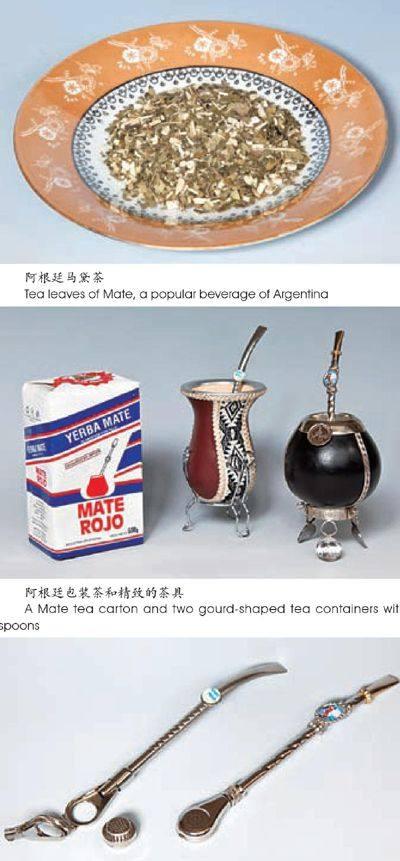在阿根廷邂逅马黛茶
2012-04-29祝永华
祝永华


千姿百态的阿根廷茶具 Cups for Mate tea drinkers
2011年8月中旬,我随团前往南美洲的阿根廷、巴西、智利等国进行商务考察。虽然时间只有短短的十二天,但南美的三大奇观——大冰川、大瀑布、大湿地给我留下了深刻的印象,阿根廷的马黛茶也让我回味无穷。
8月14日一大早,天还没亮,阿拉法特小镇还沉浸在睡梦中,我们就坐上中巴车前往阿根廷国家大冰川公园。车行片刻,只见导游端起一只葫芦状的小容器(茶杯),往里倒入开
阿根廷茶店即景 A view of a Mate teahouse in Argentina
水,再用一根不锈钢材质有些像调羹的吸管在茶杯里搅和了几下,就吮吸起来了。尔后,他又将茶杯递给驾驶员吸饮。
我就坐在导游的后排,好奇地问他:“这是什么好东西,你们一早就吸饮起来?”翻译告诉我:“这是阿根廷的国饮——名茶马黛茶。”导游随即把茶杯递过来,要我也品尝品尝。我虽然感到这种传饮方式不卫生,但出于好奇和对地主的尊重,还是接过茶杯吸了两口,头一回品尝了马黛茶。这种饮料虽然没有西湖龙井茶的那种清香,但在略带苦味中回味甘甜,人也一下子精
神起来,瞌睡也被赶走了,这是马黛茶给我的第一印象。
第二天,我们回到了布宜诺斯艾利斯,与阿根廷南美东亚商会主席冈萨雷斯 •布埃尔多先生进行商务交流时,他如数家珍般地介绍了马黛茶。他说:马黛茶是阿根廷人日常的必备饮料,由于它生长在南美一些没有遭受污染的丘陵山脉,富含196种天然元素和矿物质,对人体极为有益。当年崭露头角的博卡青年足球队球星马拉多纳,每次参加球赛前和中场休息以及终场后,都要喝马黛茶。一方面是为了补充水分,另一方面这茶确有提神的作用。马拉多纳在球场上奔跑如飞,运球自如,兴许与马黛茶不无关系。因此,马黛茶在南美也被称为“仙草”。它不仅能冲饮,而且还能食用,它所含的活性物质中,抗氧化成分占了50%以上。据说,它对机体的抗氧化作用超过了法国的红酒和中国的绿茶。所以,马黛茶在南美虽然只有四百多年的历史,但是已大量出口北美、西欧、中东和日本等地,它的经济价值不可小视。
听了冈萨雷斯 •布埃尔多主席的一番介绍,我对马黛茶产生了极大的兴趣。在交流结束时,我把带去的西湖丝绸礼品赠予他,布埃尔多主席回赠给我的正是马黛茶,这着实让我高兴了一天。回国时,我在机场里买了冲泡马黛茶的葫芦状茶杯和装饰有阿根廷国旗徽章的不锈钢吸管,和西湖区茶文化研究会的同事们分享这一份意外的收获。□
By Zhu Yonghua
My first encounter with the mate tea occurred on the early morn-ing of August 14, 2011 in a small rural town in Argentina. I was with a group of Chinese business people ready to set out to visit the Argentine National Glacier Park. We were on a 12-day visit through Brazil, Argentina and Chile. The gorgeous beauty of nature in South America was awe-inspiring, but I was also deeply impressed by the mate tea that morning. It was early dawn when we filed into the bus and the whole town was in sleep. I was sitting just behind our guide and saw him pour boiled water into a small gourd and then insert a metal straw into the gourd. He drank through the straw. Then he handed the gourd over to the driver and the driver drank from the gourd.
I was so curious that I asked what they were drinking at this time of morning. Our interpreter told me that it was the mate, a well-known beverage of Argentina. The guide handed me the gourd and indicated that I could drink from it. I knew it was not particularly sanitary to share a drink this way, but I took two cautious mouthfuls of the juice from the gourd out of curiosity and respect for the host. It did not give me the mouth feel like that of Dragon Well Tea, the well known beverage of my hometown Hangzhou, but the unusual bittersweet taste was delightfully refreshing. I felt instantly ener-gized.
The next day we were back to Buenos Aires and met with some Argentina business people. The mate beverage came up as a proud topic in the business dialogue. I learned that the plant grows in hilly areas of South America. The beverage contains 196 natural ele-ments and minerals, all needed by the human body. Mate can serve as food. In terms of anti-oxidation, it is much better than French red wine and Chinese green tea. Mate as a beverage has a history of 400 years in South America and it is now exported in large quantities to North America, West Europe, Mideast and Japan.
At the end of the meeting, I presented some silk products from Hangzhou and to my delight, got the mate tea in return. At the air-port before I boarded the plane that would carry me home, I bought a gourd-shaped cup and a stainless-steel straw decorated with a badge of Argentine national flag. Back home, I shared the mate tea
阿根廷马黛茶
Tea leaves of Mate, a popular beverage of Argentina
阿根廷包装茶和精致的茶具
A Mate tea carton and two gourd-shaped tea containers with spoons
精美的银制茶匙 Finely made silver spoons for mate tea sipping
with fellows at West Lake District Association for Tea Culture Re-search.□
